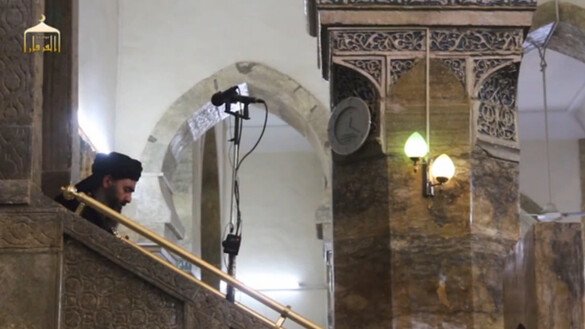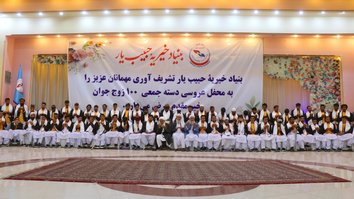The "Islamic State of Iraq and Syria" (ISIS) blew up Mosul's Grand al-Nuri Mosque and its distinctive 12th century leaning minaret last Wednesday (June 21st) before withdrawing from it as Iraqi forces closed in.
Al-Hadba (hunchback) minaret of the mosque, where ISIS leader Abu Bakr al-Baghdadi in 2014 announced the creation of his so-called "caliphate", is featured on Iraq's 10,000-dinar banknote and was the main symbol of the city.
In a statement issued after the news broke, Prime Minister Haider al-Abbadi described the group's destruction of the mosque as "an official declaration of defeat", AFP reported.
The historic mosque is inside Mosul’s Old City, the last remaining area of the city under ISIS control, which has been under siege by the Iraqi forces since March.
![The leaning minaret of Mosul's al-Nuri mosque is seen from the interior of the mosque in this file photo. Both were destroyed by the 'Islamic State of Iraq and Syria' on June 21st. [Photo courtesy of Iraqi Military Encyclopedia]](/cnmi_st/images/2017/06/26/8534-image_uploaded_from_ios_copy_2-585_329.jpg)
The leaning minaret of Mosul's al-Nuri mosque is seen from the interior of the mosque in this file photo. Both were destroyed by the 'Islamic State of Iraq and Syria' on June 21st. [Photo courtesy of Iraqi Military Encyclopedia]

'Islamic State of Iraq and Syria' leader Abu Bakr al-Baghdadi descends from the pulpit of Mosul's al-Nuri mosque after announcing the creation of a 'caliphate' in this screen shot from a June 2014 video.
On Wednesday night, Iraqi forces advanced in the Old City and were preparing to storm the mosque and expel ISIS from it, having secured the surrounding alleyways and streets.
The explosion went off as Counter Terrorism Service troops reached a position about 50 metres away from the mosque, Ninawa operations commander Lt. Gen. Abdulamir Yarallah said, according to a Military Information Unit statement.
Yarallah described the destruction of the mosque and minaret as "another historic crime" committed by ISIS.
A symbolic defeat
ISIS had rigged the mosque with explosives at an earlier time, said Iraqi MP Majid al-Gharawi, who serves on the parliamentary security and defence committee.
The group was prepared to blow up the mosque as soon as liberating forces got close "and it became certain that the end was at hand and it was inevitable that our forces would gain control of the mosque", he told Diyaruna.
It did not plan to withdraw from the mosque and leave it standing "so the liberating forces could use it to announce the end of the battle of Mosul", he said, as "the mosque had a symbolic significance among ISIS elements".
"They were not willing to allow this religious edifice, in which the establishment of their caliphate was declared, to also witness the announcement of their defeat," he said.
Al-Baghdadi made his first public appearance at the mosque's pulpit on July 4th, 2014, announcing the establishment of a "caliphate" in a Friday sermon and declaring himself "Caliph of all Muslims".
The destruction of al-Nuri Mosque "is yet another stamp of shame" on ISIS’s forehead, al-Gharawi said.
"This crime reflects not only the terrorists’ disappointment, but also the bitterness of the crushing defeat [they suffered] and confusion they now feel," he said.
'Last landmark in Mosul'
Since it overran Mosul and its surrounding area, ISIS has blown up significant archaeological sites and historic buildings, including Nabi Yunus shrine (the shrine of the prophet Jonah) and the ancient city of Nimrud.
The leaning minaret of the mosque, named for Sultan Nureddin al-Zanki and completed in 1172 AD, has long been a symbol of Mosul's cultural identity.
The mosque was "the last historic landmark left in Mosul, after the destruction of all other cultural and humanitarian landmarks in the city", Ninawa provincial council member Abdul Rahman al-Wakaa told Diyaruna.
"When the battles reached the Old City, we became very concerned that the terrorists would destroy or demolish that edifice," he said.
With the mosque's destruction, "we have lost a legacy that has stood tall for centuries, defied many invaders and survived wars and disasters throughout history", al-Wakaa said.
"It is truly regrettable that the last chapter of the liberation battles would end with a criminal and cowardly act of terrorism that targeted the last landmark that Mosulians had left, and for which their city is famous," he said.
Ninawa provincial council security committee member Hassan Shabeeb said there were fears ISIS would blow up the mosque, as it "previously destroyed mosques, shrines and tombs without any respect for religious considerations".
"We were expecting the terrorists to blow up the mosque at any moment," he told Diyaruna, noting that ISIS has committed "every heinous act there is".
A dark chapter closes in the city
The wanton destruction of Mosul's al-Nuri Mosque was met with a wave of anger and condemnation in Iraq and around the world.
The attack, which is "indicative of the militants’ vengeful mindset and sick mentality", has been widely viewed as "an official admission of defeat by ISIS", Shabeeb said.
"ISIS’s presence in the city is as good as over," he said. "The liberation operations are currently focused on how to safeguard the lives of the inhabitants of the Old City, whose number is estimated at about 100,000."
"After the rule of terrorism is brought to an end, everything can be restored and rebuilt," he added. "The only thing that is irreplaceable is the lives of civilians."
"This dark chapter of the history of our city is coming to an end," he said, stressing, along with many others, the need to rebuild al-Nuri mosque "as soon as possible", following the conclusion of fighting.

![A picture taken on June 25, 2017 shows Mosul's destroyed ancient leaning minaret, known as the "Hadba" (Hunchback), in the Old City after being blown up by ISIS fighters earlier in the week. Mosul's trademark leaning minaret was missing from its skyline for the first time in centuries. [Mohamed El-Shahed/AFP]](/cnmi_st/images/2017/06/26/8532-000_px0lm-585_329.jpg)






